|

|
|
|
|
Facial abnormalities number as the most frequent congenital anomalies (1:1000 newborns) and are often encountered in combined forms, occurring with other anomalies. Probably environmental factors as well as genetic factors play a role.
|
|
|
|
Cheiloschisis (cleft lip)
|
|
|
| Cheiloschisis is a disorder during the fusioning of the maxillary process with the prolabium (both globular processes of the medial nasolateral process). This disorder can occur unilaterally or bilaterally. |
|
Fig. 38 - Cleft lip |
|
Legend |
|
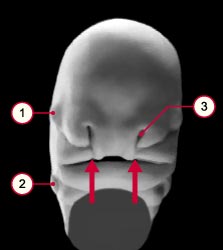
1
2
3
|
Eye anlage
Ear anlage
Nasal sac |
|
|
|
Fig. 38
The arrows point to the locations of the missing epithelial bridges between the globular and maxillary processes that lead to a unilateral or bilateral cleft lip.
|
More info
|
|
Clinically, problems with taking in nutrition in such newborns stand in the foreground. Surgical corrections are possible.
Overview of facial abnormalities.
|
|
|
|
Cheilognathoschisis (cleft lip and jaw)
|
|
|
|
In cheilognathoschisis, besides the soft tissue fusion disorder of the upper lip the fusing of the lateral edges of the primary palate with the two anterior edges of the secondary palate is also disturbed. This disorder can also occur unilaterally or bilaterally.
|
|
|
|
Cheilognathopalatoschisis (cleft lip, jaw and palate)
|
|
|
In addition to the two previously mentioned disorders there is also a fusion disorder of the left and right portions of the secondary palatine lamina.
Since it is not possible for such an infant to suck and thereby take in nourishment a surgical separation between the nasal and oral cavities must be undertaken as quickly as possible. |
|
Fig. 39 - Missing fusion in
cheilognathopalatoschisis |
|
Legend |
|
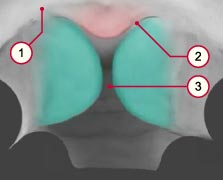
1
2
3
|
Fusion locations between maxillary
and globular processes of the
medial nasal lamina
Fusion locations between the
primary and secondary palates
Fusion locations between the two palatal processes |
|
|
|
Fig. 39
In all cleft face and lip abnormalities fusion disorders occur, i.e., no epithelial bridges are formed.
|
| The disorders that affect the whole face are much more seldom. In an oblique facial cleft a fissure runs from the lower lid edge to the lower edge of the nasal opening. This results from a deficient fusion of the epithelium of the lacrimonasal duct. It can occur unilaterally or bilaterally or even combined with a cleft lip-jaw-palate. |
|
Fig. 40 - Missing fusion of the
lacrimonasal duct |
|
Legend |
|
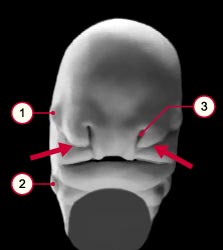
1
2
3
|
Eye
Ear anlage
Nasal sac |
|
|
|
Fig. 40
In all cleft face, lip, jaw and palates, fusion disorders have occurred, i.e., no epithelial bridges have been formed.
|
|
The middle cleft face can be understood mainly as a disorder of the bringing to the front of the nose and eyes. Thereby no flattening of the medial facial furrows occurs, e.g., between the two globular processes. It is supposed that this comes from an inhibition of tissue proliferation in this region.
The transversal cleft face can only arise via a disorder of cheek formation and a survival of the early, primitive oral fissure (macrostomia) that extends into the anlage region of the ears (between the 1st and 2nd pharyngeal arches).
|
|
|
| Fig. 41 - Middle cleft face |
|
Fig. 42 - Transverse cleft face |
|
Legend |
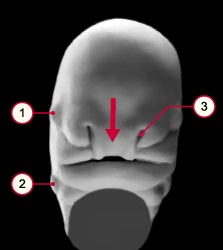
1
2
3
|
Eye
Ear anlage
Nasal sac |
|
|
|
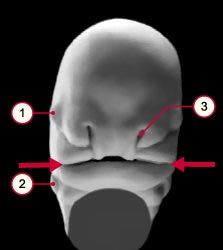
1
2
3 |
Eye
Ear anlage
Nasal sac |
|
|
|
Fig. 41; Fig. 42
The arrows show the locations where the original folds involved in face formation have not fusionned.
|
|
|

